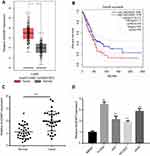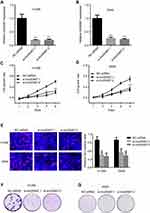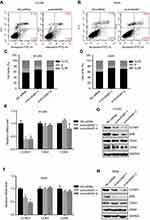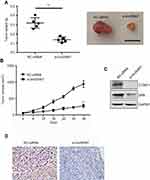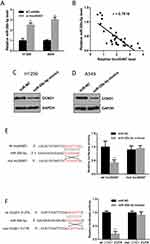Back to Journals » OncoTargets and Therapy » Volume 12
Linc00467 promotes lung adenocarcinoma proliferation via sponging miR-20b-5p to activate CCND1 expression
Authors Ding H, Luo Y, Hu K, Liu P, Xiong M
Received 6 March 2019
Accepted for publication 16 July 2019
Published 21 August 2019 Volume 2019:12 Pages 6733—6743
DOI https://doi.org/10.2147/OTT.S207748
Checked for plagiarism Yes
Review by Single anonymous peer review
Peer reviewer comments 2
Editor who approved publication: Dr Leo Jen-Liang Su
Hao Ding, Yuchuan Luo, Ke Hu, Pei Liu, Mengqing Xiong
Division of Respiratory Disease, Renmin Hospital of Wuhan University, Wuhan, People’s Republic of China
Correspondence: Ke Hu
Division of Respiratory Disease, Renmin Hospital of Wuhan University, Zhangzhidong Road No. 99, Wuhan 430060, People’s Republic of China
Tel +86 1 897 103 5988
Fax +86 0 278 804 2292
Email [email protected]
Background: Recently, numerous studies have demonstrated the emerging role of long non-coding RNAs (lncRNAs) in human cancers. Linc00467 is a newly defined lncRNA and was reported to promote cell survival in neuroblastoma. However, the function of linc00467 in lung cancer is still unclear.
Material and methods: We analyzed linc00467 expression and survival data derived from The Cancer Genome Altas lung adenocarcinoma (LUAD) dataset as well as in collected LUAD tissues. Then, we silenced linc00467 expression in two lung cancer cell lines using small interfering RNAs and explored the effect of linc00467 knockdown on cell growth in vitro and in vivo. Moreover, we revealed a novel target gene of linc00467 and elucidated the underlying competitive endogenous RNA regulatory mechanism in lung cancer cells.
Results: Our data suggested that linc00467 expression was elevated in LUAD tissues and correlated with overall survival of LUAD patients. Linc00467 knockdown resulted in reduced proliferation rate in lung cancer cells. Furthermore, we elucidated that linc00467 promoted CCND1 expression in lung cancer cells via functioning as a molecular sponge for miR-20b-5p.
Conclusion: Linc00467/miR-20b-5p/CCND1 signaling pathway may provide new insights into lung cancer treatment.
Keywords: linc00467, lung adenocarcinoma, cell growth, miR-20b-5p, CCND1
Introduction
Lung cancer is one of the most common cancer types worldwide with extremely high incidence and mortality, especially in men.1 According to histological features, lung cancer can be divided into two different general types, small cell lung carcinoma and non-small cell lung carcinoma (NSCLC). Three major histological subtypes of NSCLC are adenocarcinoma, squamous cell carcinoma, and large cell carcinoma.2 In recent decades, lung adenocarcinoma (LUAD) is considered to be the predominant type of NSCLC which accounts for approximately 35% of all lung cancer cases.3 Gene mutations, abnormal proliferation of cells, invasive cell transfer, heterogeneity, and other complex processes can lead to occurrence and development of LUAD. Late diagnosis, poor prognosis, and recurrence of LUAD remain the severest problems of clinical therapy.4 Therefore, discovery of novel prognostic biomarkers and therapeutic targets have great significance to improve current treatment of LUAD.
Cell cycle of mammalian cells is well organized and regulated by cyclin-dependent kinases (CDKs) and their partners to make sure appropriate processes of cell proliferation and cell division.5 There are four main phases of cell cycle, G0/G1, S, G2, and M. Progression of different phases were highly controlled by specific CDKs through signal induction and checkpoint inhibition. The cyclin D-CDK4/6 complex leads to G0/G1-S phase transition through two distinguished mechanisms.6 It may eliminate inhibition of two CDK inhibitors p21Cip1 and p27Kip1, which results in activation of cyclin E-CDK2. The complex can also phosphorylate the retinoblastoma (RB) tumor suppressor protein which binds with E2F transcriptional factors in natural state, thereby set E2F family members free to activate transcription of target genes that are associated with G1-S phase transition. Cyclin D1, which is encoded by CCND1 gene, functions as an important cell cycle regulator and participates in cyclin D-CDK4/6-RB pathway thus leading to cell cycle going through G1 phase to S phase.7 Many reports have shown that aberrant cell cycle normally happens in various cancer types including lung cancer.8–10 Targeting CDKs or other cyclin proteins via inhibitors such as CDK4/6 inhibitor palbociclib,11 PLK1 inhibitor rigosertib,12 provides an efficient therapy for cancer treatment. However, it is also important to investigate other mechanisms that indirectly regulate cell cycle progress and make new trial strategies.
Human genome has approximately 20,000 protein-coding genes which only account for less than 2% of the whole genome.13 It indicates that RNAs with no responsibility for coding proteins, which are defined as non-coding RNAs (ncRNAs), also play crucial roles in gene regulation. Long non-coding RNA (lncRNA) is a kind of ncRNA transcripts that are longer than 200 nucleotides and distinguished from small ncRNAs. Aberrant lncRNA expression is reported to promote tumorigenesis or indicate various cancer types occurrence including lung cancer. One example is lncRNA HOTAIR which was proved to downregulate p21 expression and contribute to cisplatin resistance in LUAD.14 Another important lncRNA MALAT1 was found to be up-regulated in early-stage NSCLC and related to cancer metastasis.15 It was then identified to be a promising biomarker for diagnosis of stage I NSCLC. LncRNA shows different functions in regulating biological processes due to its complex structure. One major mechanism is depending on its interaction with a subclass of small ncRNAs called microRNA. The competitive endogenous RNA (ceRNA) hypothesis supposes that lncRNA can form a sponge with microRNA and then eliminate degradation of target genes mediated by microRNA.16 Although increasing number of reports mentioned the vital roles of lncRNA in cancer initiation and development, it is still necessary to seek novel lncRNAs as prognostic markers or therapeutic targets.
In our study, we examined the expression of linc00467 in LUAD tissues and cell lines. Furthermore, we investigated the function of linc00467 in lung cancer cell progression using in vitro and in vivo experiments. Mechanistically, we revealed a novel linc00467/miR-30b-5p/CCND1 signaling in LUAD cells, providing new insight into lung cancer therapy.
Materials and methods
Clinical tissue samples
A total of 33 LUAD tissues as well as adjacent normal lung tissues were collected from Renming Hospital of Wuhan University. The experimental procedures were approved by the ethics committee of Renming hospital. Written informed consents were obtained from all patients and this procedure was conducted in accordance with the Declaration of Helsinki. Fresh tissues were frozen down in liquid nitrogen and reserved for the following RNA isolation assay.
Cell culture
Human LUAD cell lines H1299, H23, A549, and HCC827 and normal lung fibroblast cell line IMR90 were obtained from Shanghai Institute of Cell Biology, Chinese Academy of Sciences (Shanghai, China). Cells were maintained in an incubator which contained 5% CO2 at 37°C and provided with a humidified atmosphere. Dulbecco’s modified Eagle Medium (Thermo Fisher Scientific, San Jose, CA, USA) supplemented with 10% (v/v) Fetal Bovine Serum (Invitrogen, Carlsbad, CA, USA), penicillin (100 U/mL), and streptomycin (100 mg/mL; Sigma-Aldrich, St. Louis, MO, USA) was utilized for culturing lung cell lines in vitro.
Small RNA transfection assay
Small interfering RNAs (siRNAs) targeting linc00467 and negative control (NC) siRNA were synthesized by GenePharma (Shanghai, China). The miR-20b-5p mimics and NC mimics were also purchased from GenePharma. Related synthetic RNA sequences were as follows:
si-linc00467-1, 5ʹ-GCAAGACUCUGUCUACAAA-3ʹ. si-linc00467-2, 5ʹ- GGAUAUUAACUCAAGGUAA-3ʹ. miR-20b-5p mimics, 5ʹ-CAAAGUGCUCAUAGUGCAGGUAG-3ʹ. Lipofectamine 2000 (Invitrogen, Carlsbad, CA, USA) was used to transfect oligonucleotides into A549 and H1299 cell lines according to the manufacturer’s instructions.
CCK-8 assay, EdU assay, and colony formation assay
Cell proliferation was examined using cell counting kit-8 (CCK-8, Beyotime, Shanghai, China) and Cell-Light EdU Kit (Ribobio, Guangzhou, China). For CCK-8 assay, cells transfected with siRNAs were plated at an amount of 3 × 103 into each well of 96-well plates (n=5). 10% (v/v) CCK8 solution was added into each well every day at the same time during a 5-day culturing. After incubating and protected from light at 37°C for 2 hrs, 800 TS Absorbance Reader (BioTek Instruments, Winooski, VT, USA) was used to read values of OD 450 nm.
Transfected cells were harvested at their logarithmic growth phase and re-seeded into 96-well plates at a concentration of 1×105 per well. After one-day incubation, EdU assay was performed according to instructions and images were observed by Zeiss LSM710 confocal laser microscope (Zeiss, Germany).
For colony formation assay, 1×103 cells were plated into each three wells of six-well plates. After culturing for 14 days under normal conditions, colonies were fixed by methanol, stained using 0.1% crystal violet and washed cleanly for photography.
Cell cycle and apoptosis analysis
After transfection for 2 days, cells were collected to analyze cell cycle using Cell Cycle Detection Kit (Keygen biotech, Nanjing, China) and apoptosis using FITC Annexin V Apoptosis Detection Kit (BD Biosciences, San Jose, CA, USA) according to the manufacturer’s protocols.
Briefly, after harvesting and washing cell pellets, 70% cold ethanol was used to resuspend and fix cells over 2 hrs at 4°C. Fixed cells were then incubated with RNase at 37°C for 30 mins followed by mixing with Propidium Iodide (PI) staining solution and incubated for another 30 mins at 4°C.
Apoptotic cells were washed and resuspended in 1× Annexin V binding buffer. FITC Annexin V and PI were added into the solution for 15 mins incubation in the dark.
All following analysis was then performed by LSR II flow cytometer (BD Biosciences).
RNA preparation and real-time PCR
Total RNA from tissues and cell lines was isolated using TRIzol reagent (Invitrogen). HiScript 1st Strand cDNA Synthesis Kit (Vazyme Biotech, Nanjing, China) was used to synthesize cDNA for following real-time PCR analysis. Real-time PCR was performed using AceQ qPCR SYBR Green Master Mix (Vazyme Biotech) on an ABI 7900 system (Applied Biosystems, Foster City, CA, USA) in triplicate. The primer sequences used were as follows:
linc00467 forward, 5ʹ-CAGCACCGATCCCGACATAG-3ʹ, reverse, 5ʹ- CTGGCTTCCTGAAGACGATGA-3ʹ. CCND1 forward, 5ʹ- GCTGCGAAGTGGAAACCATC-3ʹ, reverse, 5ʹ- CCTCCTTCTGCACACATTTGAA-3ʹ.
Cell lysates preparation and Western blot analysis
Cells were resuspended in RIPA lysis buffer (150 mM NaCl, 1% Nonidet P-40, 0.5% Sodium deoxycholate, 0.1% SDS, 25 mM Tris pH 7.4). Cell lysates were incubated on ice for 20 mins and supernatants were collected after high-speed centrifuge at 4°C. Protein concentration was measured by Bradford assay. Samples were loaded evenly into SDS-PAGE and transferred onto PDVF membranes (Roche). Membranes were blocked in 5% skim milk at room temperature and then incubated with primary antibodies overnight at 4°C. After washing with PBS-T (PBS solution, 0.1% Tween-20) and incubation of secondary antibodies, membranes were incubated with ECL Western Blotting Substrate (Thermo Fisher Scientific) and protein bands were developed in dark room. Antibodies used for Western blot assay were: CCND1 (abcam, ab16663), pRb (abcam, ab184796), CDK4 (abcam, ab199728), CDK6 (abcam, ab54576), GAPDH (abcam, ab9485).
Tumor xenograft model in nude mice
The animal experimental procedures were performed according to the National Institutes of Health’s Guide for the Care and Use of Laboratory Animals, and were approved by the Institutional Review Board of Renmin Hospital. 6-week-old female nude mice purchased from the Model Animal Research Center of Nanjing University (Nanjing, China) were fed under specific pathogen-free conditions at Renmin hospital. To induce tumorigenesis, 1 × 106 transfected cells resuspended in 100 μL PBS containing 10% Matrigel (Sigma-Aldrich) were injected s.c. into each flank of nude mice (n=5). Tumor volumes were measured every 4 days after injection. Tumor weight was measured after mice being euthanized at indicated time points.
Luciferase assay
Wild type (wt) and mutant fragments of linc00467 or CCND1 3ʹ-UTR containing miR-20b-5p binding sites were synthesized by GenePharma and subcloned into luciferase reporter vector pGL3 (Promega, Madison, Wisconsin, USA). β-galactosidase (β-gal) expression plasmid (Invitrogen) and miRNA mimics were co-transfected with wt or mutant vectors into cells using Lipofectamine 2000 (Invitrogen). β-gal plasmid could catalyze substrates to get measurable color and suggested transfection efficiency. After 48 hrs transfection, relative luciferase activity was measured by Dual-Luciferase Assay Kit (Promega).
Statistical analysis
All experiments were repeated at least three times. GraphPad Prism (version 8, La Jolla, CA) was used to analyze data statistically. All data were presented as mean ± standard deviation. The significance between two groups was evaluated using Student’s t-test. P-value <0.05 was considered to be significant.
Results
Linc00467 was up-regulated in lung adenocarcinoma tissues and cell lines
To investigate whether linc00467 may play a role in lung cancer, we firstly explored the relevant information of linc00467 in The Cancer Genome Altas database. We found that linc00467 expression was elevated in LUAD (Figure 1A). Moreover, high linc00467 expression was correlated with poor overall survival of lung cancer patients (Figure 1B). Then, we examined linc00467 expression in collected LUAD tissues. Real-time PCR analysis showed that linc00467 expression was significantly up-regulated in LUAD tissues compared to adjacent normal tissues (Figure 1C). We also analyzed linc00467 expression in four LUAD cell lines (H1299, H23, HCC827, and A549) as well as in IMR90 lung fibroblast cell line and got similar results (Figure 1D). Linc00467 expression in H1299 and A549 cell lines was higher than in other two lung cancer cell lines, so we used H1299 and A549 cell lines for the following experiments. The above data indicated that linc00467 levels were up-regulated in human LUAD tissues and high expression of linc00467 was correlated with poor prognosis, suggesting that linc00467 may promote lung cancer malignant progression.
Linc00467 knockdown inhibited lung cancer cell growth
To explore the role of linc00467 in lung cancer progression, we transfected H1299 and A549 cells with small interference RNAs targeting linc00467 (silinc00467-1, silinc00467-2). Knockdown efficiency was confirmed by real-time PCR analysis (Figure 2A and B). We found that linc00467 silencing significantly inhibited cell growth in H1299 and A549 cells (Figure 2C and D). This result was further confirmed by EdU cell proliferation assay (Figure 2E). Moreover, colony formation assay showed that linc00467 knockdown impaired cell reproductive capacity in lung cancer cells (Figure 2F and G). These data suggested that linc00467 was essential for lung cancer cell proliferation.
Linc00467 knockdown led to lung cancer cell G0/G1 arrest
As cell growth was impaired in linc00467 knockdown lung cancer cells, we next investigated whether cell cycle progress and apoptosis were affected by linc00467 expression levels in these cells. Cell apoptosis was analyzed by cell flow cytometry and the result showed that linc00467 had no effect on cell apoptosis in lung cancer cells (Figure 3A and B). Then, we examined cell cycle and found that inhibition of linc00467 expression resulted in cell cycle arrest at the G0/G1 phase in lung cancer cells (Figure 3C and D). To further investigate the function of linc00467 in cell cycle arrest, we analyzed G1 checkpoint-related protein expression using real-time PCR and Western blot. Real-time PCR analysis suggested that CCND1 expression was inhibited in linc00467 knockdown cells (Figure 3E and F). Consistently, Western blot result showed that CCND1 and its downstream target phosphorylated RB (pRB) levels were decreased in linc00467 knockdown lung cancer cells (Figure 3G and H). These data suggested that linc00467 played an important role in cell cycle via regulating CCND1 expression.
Linc00467 knockdown inhibited tumor growth in vivo
To elucidate the effect of linc00467 on tumor growth in vivo, we subcutaneously injected A549 cells which were transfected with linc00467 siRNA or NC siRNA into nude mice. As shown in Figure 4A and B, tumor weight and volume were significantly reduced in linc00467 knockdown group. Western blot analysis showed that CCND1 and pRB levels were decreased in linc00467 knockdown group compared with the NC group (Figure 4C). Immunohistochemical staining result indicated that CCND1 protein levels were decreased in tumors from linc00467 knockdown group (Figure 4D). These results suggested that linc00467 promoted lung cancer cell growth and were consistent with in vitro data above.
Linc00467 acted as a sponge of miR-20b-5p in lung cancer cells
To investigate the underlying mechanism of linc00467 in CCND1 regulation, we analyzed potential ceRNA regulatory network of linc00467 and found that miR-20b-5p may be correlated with linc00467. We first examined miR-20b-5p expression and found that miR-20b-5p levels were increased in linc00467 knockdown lung cancer cells (Figure 5A). Also, miR-20b-5p levels in lung cancer tissues were negatively correlated with linc00467 levels (Figure 5B). Then, we transfected A549 and H1299 cells with miR-20b-5p mimics and found that CCND1 protein levels were decreased compared with cells transfected with miR-NC (Figure 5C and D). Moreover, we generated luciferase reporter gene vectors containing wt or mutant (mut) miR-20b-5p binding sites in linc00467 gene or CCND1 3ʹ-UTR region. Dual luciferase reporter assay results suggested that miR-20b-5p mimics inhibited luciferase activities of wt linc00467 and CCND1 3ʹ-UTR vectors but not the mutant vectors (Figure 5E and F). These results demonstrated that linc00467 promoted CCND1 expression via sponging miR-20b-5p in lung cancer cells.
Discussion
Lung cancer is a leading cause of cancer death all over the world. It is very important to develop new biomarkers and therapeutic targets for lung cancer. lncRNAs are a type of non-protein coding RNAs longer than 200nt nucleotides. In recent years, increasing studies have demonstrated the functional roles of lncRNAs in human physiological and pathological processes.17 It has been proved that dysregulated lncRNAs are essential for initiation and progression in human cancers. For instance, it was reported that lncRNA AB074169 expression was downregulated in papillary thyroid carcinoma and its overexpression led to cell cycle arrest and tumor growth inhibition through promoting p21 expression in papillary thyroid carcinoma cells.18 A highly conserved lncRNA, metastasis-associated lung adenocarcinoma transcript 1 (MALAT1) was reported to be involved in lung cancer metastasis and could serve as a biomarker for lung cancer development. Moreover, small molecules targeting MALAT1 had shown promising anticancer effects in vivo.19 In this research, we found that linc00467 expression was up-regulated in LUAD and was correlated with overall survival of LUAD patients. We proved that linc00467 promoted lung cancer proliferation in vitro and in vivo. These results indicated that linc00467 might be a potential biomarker and therapeutic target for lung cancer.
CCND1 is a major regulator of cell cycle G0/G1 checkpoint and is essential for downstream Rb phosphorylation and E2F transcription factor family activation. There are many studies have demonstrated that CCND1 expression was overexpressed in many human cancers like lung cancer, breast cancer, and melanoma.20–22 It is important to explore potential signaling pathways in CCND1 regulation in human cancers. Here, we elucidated a novel role of linc00467 in CCND1 regulation which might help us to understand the function of lncRNAs in lung cancer cell cycle regulation.
A previous study reported that linc00467 promoted neuroblastoma cell survival.23 However, the underlying molecular mechanism of linc00467 in human cancer was still unclear. ceRNA is one of the major lncRNA-related regulatory mechanisms. Therefore, we predicted linc00467 interacting with miRNA using bioinformatics analysis. We found that miR-20b-5p could bind to linc00467 as well as CCND1 3ʹ-UTR region and luciferase reporter gene assay confirmed our hypothesis. MiR-20b-5p expression was up-regulated in linc00467 knockdown lung cancer cells and its expressions in lung cancer tissues were negatively correlated with linc00467 levels. In addition, miR-20b-5p mimics transfection inhibited CCND1 expression in the lung cancer cell. Hence, it might be explained that linc00467 promoted CCND1 expression via acting as a sponge for miR-20b-5p in lung cancer cells. The function of miR-20b-5p in lung cancer progression is still uncertain so far. Our study indicated that miR-20b-5p might act as a tumor suppressor gene in lung cancer progression and further research is required.
Conclusion
In summary, our study revealed a linc00467/miR-20b-5p/CCND1 signaling pathway in lung cancer progression. Linc00467 was overexpressed in lung cancers and promoted lung cancer cell growth and metastasis in vitro and in vivo. Mechanistically, linc00467 activated CCND1 expression through interacting with miR-20b-5p in lung cancer cells. Our study demonstrated that linc00467 might be a potential biomarker and therapeutic target in lung cancer treatment.
Availability of data and materials
All data generated or analyzed during this study are included in this published article.
Acknowledgment
This work was supported by Zhenjiang Social Development Project SH2018077.
Disclosure
The authors report no conflicts of interest in this work.
References
1. Siegel RL, Miller KD, Jemal A. Cancer statistics. CA Cancer J. Clin. 2019;69(1):7-34. doi:10.3322/caac.21551
2. von der Thusen JH, Tham YS, Pattenden H, et al. Prognostic significance of predominant histologic pattern and nuclear grade in resected adenocarcinoma of the lung: potential parameters for a grading system. J Thorac Oncol. 2013;8(1):37–44. doi:10.1097/JTO.0b013e318276274e
3. Sun Q, Jiang CW, Tan ZH, et al. MiR-222 promotes proliferation, migration and invasion of lung adenocarcinoma cells by targeting ETS1. Eur Rev Med Pharmacol Sci. 2017;21(10):2385–2391.
4. Liu X, Wang J, Chen M, Liu S, Yu X, Wen F. Combining data from TCGA and GEO databases and reverse transcription quantitative PCR validation to identify gene prognostic markers in lung cancer. Onco Targets Ther. 2019;12:709–720. doi:10.2147/OTT.S183944
5. Otto T, Sicinski P. Cell cycle proteins as promising targets in cancer therapy. Nat Rev Cancer. 2017;17(2):93–115. doi:10.1038/nrc.2016.138
6. Sherr CJ, Roberts JM. Living with or without cyclins and cyclin-dependent kinases. Genes Dev. 2004;18(22):2699–2711. doi:10.1101/gad.1256504
7. Leone G, DeGregori J, Jakoi L, Cook JG, Nevins JR. Collaborative role of E2F transcriptional activity and G1 cyclindependent kinase activity in the induction of S phase. Proc Natl Acad Sci U S A. 1999;96(12):6626–6631. doi:10.1073/pnas.96.12.6626
8. Chen D, Guo W, Qiu Z, et al. MicroRNA-30d-5p inhibits tumour cell proliferation and motility by directly targeting CCNE2 in non-small cell lung cancer. Cancer Lett. 2015;362(2):208–217. doi:10.1016/j.canlet.2015.03.041
9. Nie FQ, Sun M, Yang JS, et al. Long noncoding RNA ANRIL promotes non-small cell lung cancer cell proliferation and inhibits apoptosis by silencing KLF2 and P21 expression. Mol Cancer Ther. 2015;14(1):268–277. doi:10.1158/1535-7163.MCT-14-0492
10. Liu B, Qu J, Xu F, et al. MiR-195 suppresses non-small cell lung cancer by targeting CHEK1. Oncotarget. 2015;6(11):9445–9456. doi:10.18632/oncotarget.3255
11. Sherr CJ, Beach D, Shapiro GI. Targeting CDK4 and CDK6: from discovery to therapy. Cancer Discov. 2016;6(4):353–367. doi:10.1158/2159-8290.CD-15-0894
12. Gumireddy K, Reddy MV, Cosenza SC, et al. ON01910, a non-ATP-competitive small molecule inhibitor of Plk1, is a potent anticancer agent. Cancer Cell. 2005;7(3):275–286. doi:10.1016/j.ccr.2005.02.009
13. Djebali S, Davis CA, Merkel A, et al. Landscape of transcription in human cells. Nature. 2012;489(7414):101–108. doi:10.1038/nature11233
14. Liu Z, Sun M, Lu K, et al. The long noncoding RNA HOTAIR contributes to cisplatin resistance of human lung adenocarcinoma cells via downregualtion of p21(WAF1/CIP1) expression. PLoS One. 2013;8(10):e77293. doi:10.1371/journal.pone.0077293
15. Ji P, Diederichs S, Wang W, et al. MALAT-1, a novel noncoding RNA, and thymosin beta4 predict metastasis and survival in early-stage non-small cell lung cancer. Oncogene. 2003;22(39):8031–8041. doi:10.1038/sj.onc.1206928
16. Poliseno L, Salmena L, Zhang J, Carver B, Haveman WJ, Pandolfi PP. A coding-independent function of gene and pseudogene mRNAs regulates tumour biology. Nature. 2010;465(7301):1033–1038. doi:10.1038/nature09144
17. Wapinski O, Chang HY. Long noncoding RNAs and human disease. Trends Cell Biol. 2011;21(6):354–361. doi:10.1016/j.tcb.2011.04.001
18. Gou Q, Gao L, Nie X, et al. Long noncoding RNA AB074169 inhibits cell proliferation via modulation of KHSRP-mediated CDKN1a expression in papillary thyroid carcinoma. Cancer Res. 2018;78(15):4163–4174. doi:10.1158/0008-5472.CAN-17-3766
19. Gutschner T, Hammerle M, Eissmann M, et al. The noncoding RNA MALAT1 is a critical regulator of the metastasis phenotype of lung cancer cells. Cancer Res. 2013;73(3):1180–1189. doi:10.1158/0008-5472.CAN-12-2850
20. Betticher DC, Heighway J, Hasleton PS, et al. Prognostic significance of CCND1 (cyclin D1) overexpression in primary resected non-small-cell lung cancer. Br J Cancer. 1996;73(3):294–300. doi:10.1038/bjc.1996.52
21. Elsheikh S, Green AR, Aleskandarany MA, et al. CCND1 amplification and cyclin D1 expression in breast cancer and their relation with proteomic subgroups and patient outcome. Breast Cancer Res Treat. 2008;109(2):325–335. doi:10.1007/s10549-007-9659-8
22. Vizkeleti L, Ecsedi S, Rakosy Z, et al. The role of CCND1 alterations during the progression of cutaneous malignant melanoma. Tumor Biol. 2012;33(6):2189–2199. doi:10.1007/s13277-012-0480-6
23. Atmadibrata B, Liu PY, Sokolowski N, Zhou Y. The novel long noncoding RNA linc00467 promotes cell survival but is down-regulated by N-Myc. PLoS One. 2014;9(2):e88112. doi:10.1371/journal.pone.0088112
 © 2019 The Author(s). This work is published and licensed by Dove Medical Press Limited. The full terms of this license are available at https://www.dovepress.com/terms.php and incorporate the Creative Commons Attribution - Non Commercial (unported, v3.0) License.
By accessing the work you hereby accept the Terms. Non-commercial uses of the work are permitted without any further permission from Dove Medical Press Limited, provided the work is properly attributed. For permission for commercial use of this work, please see paragraphs 4.2 and 5 of our Terms.
© 2019 The Author(s). This work is published and licensed by Dove Medical Press Limited. The full terms of this license are available at https://www.dovepress.com/terms.php and incorporate the Creative Commons Attribution - Non Commercial (unported, v3.0) License.
By accessing the work you hereby accept the Terms. Non-commercial uses of the work are permitted without any further permission from Dove Medical Press Limited, provided the work is properly attributed. For permission for commercial use of this work, please see paragraphs 4.2 and 5 of our Terms.

